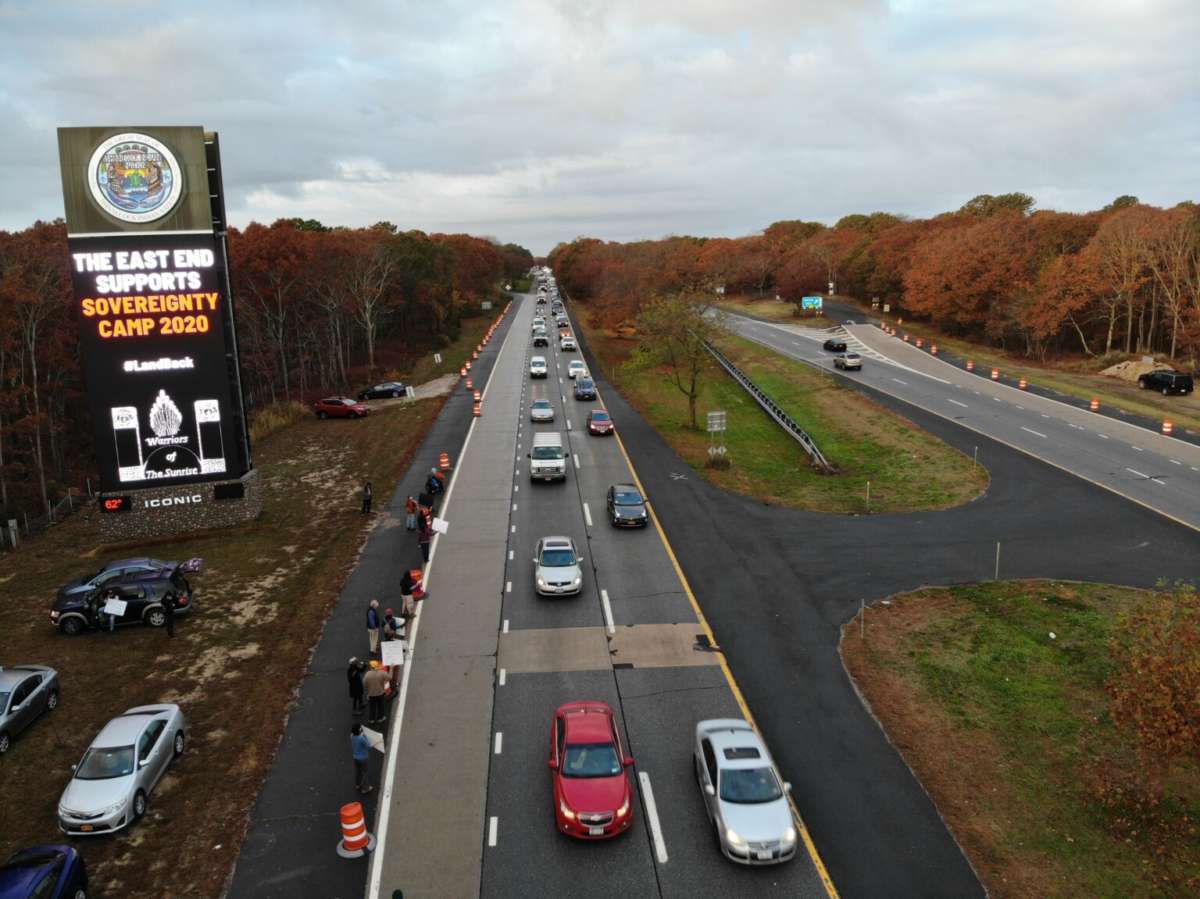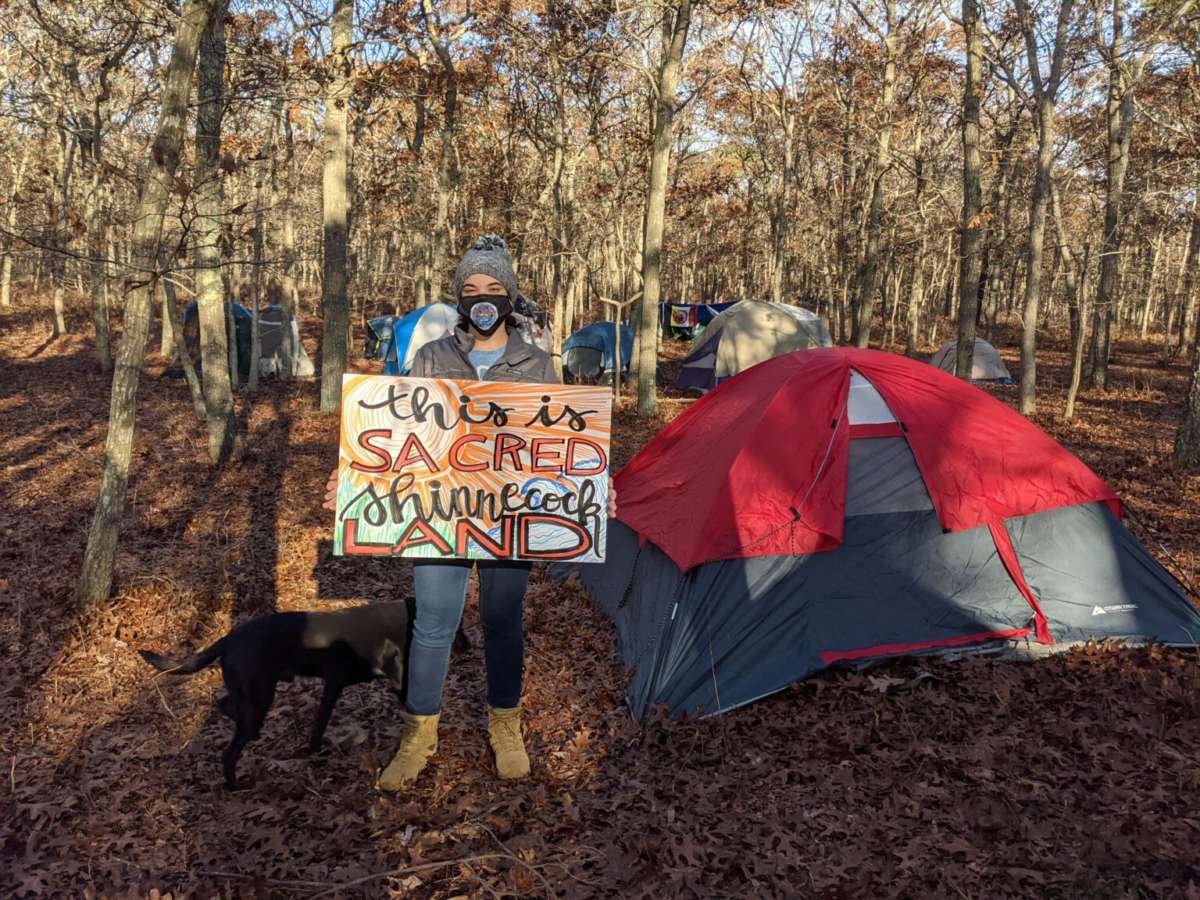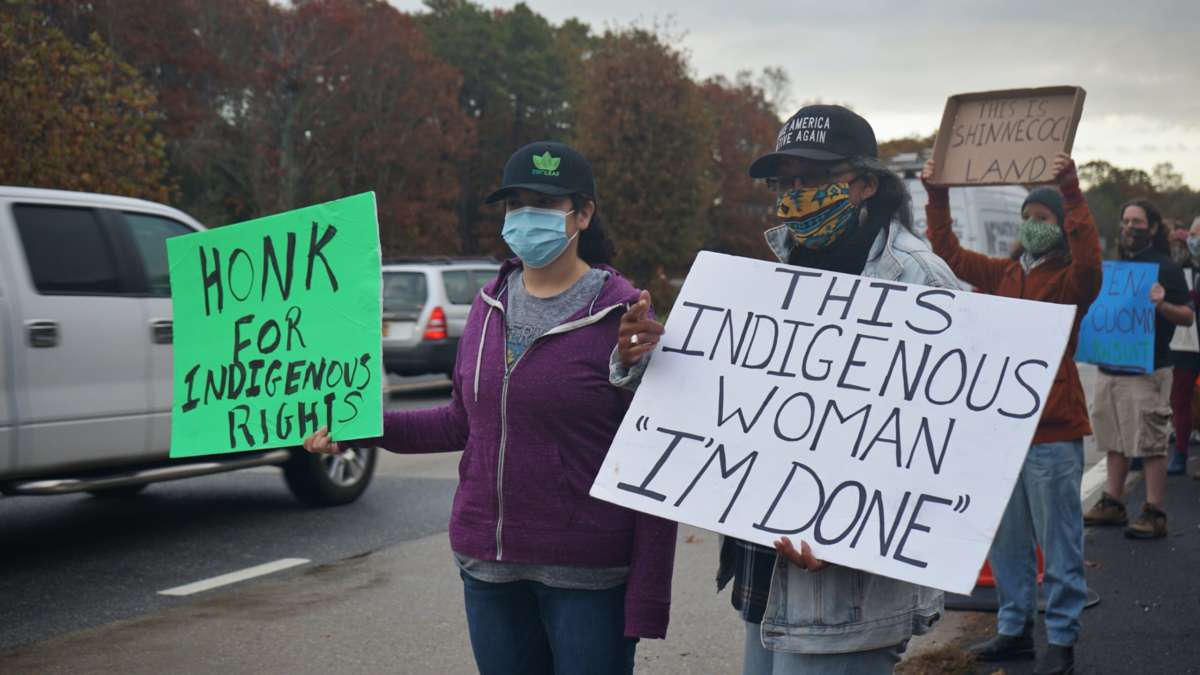Did you know that Truthout is a nonprofit and independently funded by readers like you? If you value what we do, please support our work with a donation.
Between the Atlantic Ocean and the Peconic Bay of Long Island, there is an isthmus known as Canoe Place. Thousands of years ago, the land was where the native Shinnecock tribe carried their canoes during travel. Today, the territory is surrounded by the glitzy luxury housing of the Hamptons. It is also the site of Sovereignty Camp 2020, where Indigenous Shinnecock activists have been demanding justice for their people since the beginning of November.
The occupation is being led by the Warriors of the Sunrise, a group made up mostly of Shinnecock elders who are affectionately known by their community as “the Grandmothers.” The Grandmothers’ primary demand: an end to the legal battle that the state of New York has waged against the Shinnecock Nation for more than a year.
The lawsuit began in May 2019, when the Shinnecock Nation erected a 61-foot monument on Sunrise Highway, the only expressway into the Hamptons. The monument, which is topped with the seal of the Shinnecock Nation, serves two purposes: first, it is a tribute to Shinnecock resilience and a reminder to passersby that they are driving on tribal land. Beneath the seal is an electronic billboard, where companies can pay to advertise to the wealthy clientele of the Hamptons — a way for the tribe to generate desperately-needed revenue. This quickly resulted in an uproar from public officials and wealthy vacationers, who objected to it on grounds that it was an “eyesore” that could “potentially distract motorists.”

Soon after, the state of New York filed a temporary restraining order against the project, despite the fact that it was located on land that rightfully belonged to the Shinnecock. The second monument that the tribe had planned was never built. Now, as the Shinnecock community struggles to feed and house their people during a global pandemic, they are being forced to pay thousands in legal defense fees.
The youngest among the Warriors of the Sunrise is Tela Troge, a 33-year-old attorney who helped envision the monument and defend it in court. Troge, who grew up in Shinnecock territory, has known the Grandmothers since she was a baby. “People may not be ready to hear the truth, but when it’s a grandmother yelling at you about the way it is, you stop and you listen,” she said.
For the past few weeks, she has been helping run Sovereignty Camp 2020, where more than 30 activists plan to camp until Thanksgiving. Troge describes the camp as “a place where anyone can share a story and know there’s going to be somebody to listen.” There, the warriors have staged protests, established Shinnecock history classes, and compiled a library of Native authors. At night, the Grandmothers sit around the fire and recount details of the Indigenous occupation of Alcatraz and the American Indian Movement of the 1960s.
So far, the movement has garnered inter-tribal support, a steady stream of visitors and thousands of dollars in donations. “We’ve gotten messages from people around the world who have grievances with billionaires living on stolen land,” Troge said. “A lot of the donations are labeled ‘back rent.’”
I spoke with Troge about the occupation, Shinnecock history and how to stand in solidarity with Indigenous people this Thanksgiving.
Loretta Graceffo: How did the occupation come together?
Tela Troge: The occupation has been envisioned by Margo Thunderbird — one of the grandmothers — for at least 45 years. But the monument is what made it possible for us to gather here. It really strengthened us and unified us. The first time it was lit up, my entire tribe came out. I’m 33 years old, and it was the first time I’ve ever seen everyone in my tribe happy and able to come together.

Since then, we’ve built the alliances we needed to have a meaningful occupation. It feels like the stars aligned to make this possible. We’ve been saying all of these things for hundreds of years, and no one’s listened to us. But we’re going to have people hear us this time.
One of the reasons this lawsuit is so devastating is because the monument is more than just a tribute to your people — it’s also an opportunity for your tribe to generate revenue. How has the lawsuit affected economic development in your community?
The monument has two visual screens that we have advertising on. When we were starting to build, we had contracts with all of these internationally well-known companies. But we lost every single one of those contracts because the town came in with the assertion that it wasn’t our land.
People really turned against us. Our neighbors turned against us, and the advertisers turned against us. There was a group of local residents who, if they saw your ad up on the sign, they would boycott you. We’ve really been struggling to put up the second sign that we planned. No bank wants to finance you when your project is under litigation.
It’s insane, and this isn’t the first time that New York state or the town of Southampton has done this. It’s just been this history of 400 years of flat-out economic oppression.
How has the economic oppression of the Shinnecock people manifested over the years?
Our territory is surrounded by the town of Southampton. Our neighbors are some of the wealthiest people in the world. They’re celebrities and millionaires with these gigantic summer estates. And meanwhile, our people are literally living in campers, or 200-year-old houses with no roofs. Or they’re living in tents — if they’re lucky enough to even have a tent. The housing conditions are absolutely horrific, but if you drive a minute down the road, you’ll see the biggest house you’ve ever seen in your life. It’s absolutely sickening and disgusting.
We have about 1,200 Shinnecock people who are living on our territory. Since we only have 800 acres of land, we’re running out of room. We’re on a peninsula that’s extraordinarily vulnerable to flooding and storms, so not many of the acres are even livable.
We don’t have addresses, so we can’t get bank accounts. And because of that, we’re unable to obtain any type of financing that would allow us to build new homes, or improve the structures of the ones we have. The rest of the world depends on mortgages for that kind of thing. But we just don’t have any access to that capital at all, and we can’t generate our own through economic development.
You’re also the COVID-19 director for your nation. What has been the impact of the pandemic on your community?
I’ve had families come to me with absolutely heartbreaking struggles. Things were bad before the pandemic, but things are even worse now. There’s a lot of food insecurity. Even with the food bank, so much of the food is high sodium, and a lot of people are affected by diabetes and can’t even eat that. And a lot of young families lack access to baby supplies like diapers and formula.
Homelessness is also a huge concern. A lot of homeless people in the territory were using the church for shelter, but with COVID-19, that became a safety issue. And since so many families have three or four generations of family living in one home, there’s not really any way to quarantine and protect the more vulnerable elders of the family. So it’s a huge challenge we’re facing as we’re going into winter.
Another thing you’re fighting for is trust land, a land status that grants Native tribes a certain level of sovereignty and protection. Why has trust land been historically denied to your tribe?
Our tribe’s relationship has always been with the town of Southampton, and the state of New York. We’ve never had a federal relationship with the United States, because we had a relationship with the colonists before the United States was even formed. We’re in a similar situation to the Mashpee Wampanoag, the tribe most people know from their engagement with the Pilgrims.

In 1934, as part of the New Deal, there was the Indian Reorganization Act. Washington sent out an agent to our community to explore the possibility of starting a federal relationship with us. The agent they sent ended up writing back to Washington saying that he felt our features were more African than Indian, and because of that, we’ve always been overlooked by the United States. We’ve never been provided with any type of assistance from colonial oppressors.
This was all based on racial policy at the time. Back then, Long Island was a hotspot for eugenics. The super wealthy people out here were engaging with all kinds or research about racial tyranny at Cold Spring Harbor Laboratory, which isn’t far from our territory. There’s a really horrible history of racial prejudice there.
What are some of your other demands?
New York state is one of four states in the country that has no laws to protect unmarked Native graves. Shinnecock Hills is one of our most sacred burial sites. It was stolen from us, and developers have been digging up our ancestors to build houses, pools and tennis courts. They do it right in front of us. I can’t describe how horrible it is to watch them taking our skulls out of the earth so that they can build a house — and then fighting with us when we tell them it’s the wrong thing to do. It’s the worst thing you could ever see in your life.
Another thing we’re fighting for is our sovereign right to hunt and fish. This was one of the basic agreements we had with early colonial governments, but they’ve never been honored. It’s even worse during the pandemic, because we’re at the point where we need to hunt and fish to support our people, but we’re under attack for trying to exercise that right.
For many Indigenous people, Thanksgiving is a National Day of Mourning to reflect on settler colonization and genocide. As the holiday approaches, what are some ways that non-Natives can stand in solidarity with Indigenous folks?
I want people to know the true, raw history of early America, and the true history of Thanksgiving. It’s not people’s fault that they were never taught this, but I want people to know who the Mashpee Wampanoag are. I don’t want to have to say, “Oh, they’re the Thanksgiving tribe.”
There’s a lot of other ways people can stand in solidarity with us, too. They can come down to Sovereignty Camp, or they can make a donation on GoFundMe or PayPal. But what we really need is for people to call the governor of New York, or the attorney general, and ask them to drop the lawsuit. If you’re going to do one thing to honor and recognize Native people during this time, that’s an action you can take.
As one of the architects of the monument, you’ve been a part of this movement from the beginning. What has been the most fulfilling part?
Having everyone come together has been really beautiful. And standing on the edge of the water on my ancestral land, knowing that I’m looking at the same thing that my ancestors looked at 10,000 years ago — I just can’t describe how incredible that is. I love where I’m from, and I’ll do anything to protect it.
Press freedom is under attack
As Trump cracks down on political speech, independent media is increasingly necessary.
Truthout produces reporting you won’t see in the mainstream: journalism from the frontlines of global conflict, interviews with grassroots movement leaders, high-quality legal analysis and more.
Our work is possible thanks to reader support. Help Truthout catalyze change and social justice — make a tax-deductible monthly or one-time donation today.
